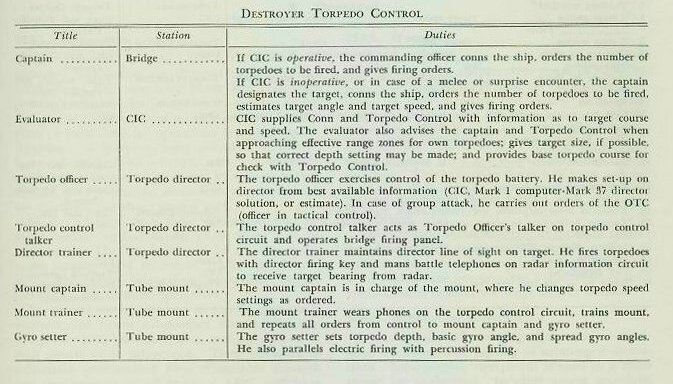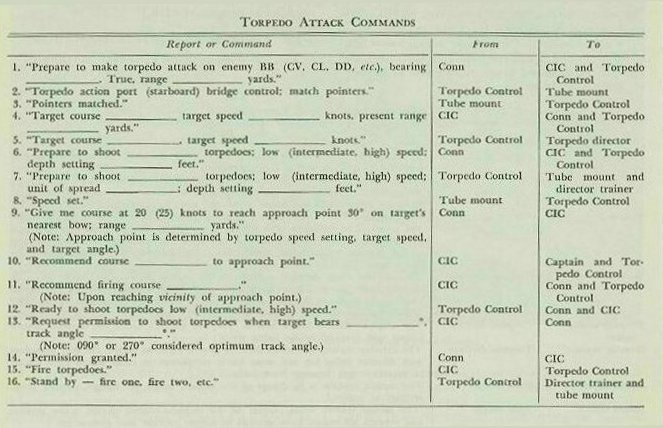| GENE SLOVER'S US NAVY FIRE CONTROL PAGES NAVAL ORDNANCE AND GUNNERY VOLUME 2, FIRE CONTROL CHAPTER 27 TORPEDO FIRE CONTROL |
| HOME INDEX Chapter 27 Torpedo fire control A. General B. Destroyer torpedo fire control problem C. Destroyer torpedo fire control system D. CIC's function in the radar-aim torpedo attack |
| D. CIC’s Function in The Radar-Aim Torpedo Attack 27D1. Introduction The radar-aim, director-controlled, destroyer torpedo attack became highly developed during World War II. In any discussion of torpedo fire control, we must therefore include this type of attack and the function of CIC in making it. The line of sight to the target is established by the torpedo-director trainer, keeping follow-the-pointer bearing dials matched in the bearing repeater located on the right side of the Mark 27 torpedo director (see fig. 27C2). By means of a selector switch, target bearing may be received by this repeater either from the fire control radar, or from search radar. Fire control radar bearings are preferred, as they provide greater accuracy. 27D2. Shipboard stations active in the radar-aim torpedo attack The conning station, main-battery director (Director Mark 37), plotting room, Combat Information Center, Torpedo Control, and torpedo-tube mount all have important functions in delivering the radar-aim torpedo attack. CIC tracks the target, designates the target to the main-battery director, keeps Conn and Torpedo Control informed of all target movements, and checks the solution of target course and speed with the plotting-room computer solution. Initially, CIC must give Conn a course to an approach point which will put the ship in good position to make an attack. This approach point is usually a general location approximately 30° to 40° on the target’s nearest bow just outside the effective range of the torpedo to be fired. Upon reaching the approach point, CIC recommends a firing course to Conn which will keep the target within effective range for a reasonable period of time and allow a firing bearing which will produce the optimum track angle of approximately 090 degrees or 270 degrees. When the ship on the firing course approaches the firing bearing, CIC so informs the captain and requests permission to fire torpedoes. Torpedo Control, on the command of CIC, fires torpedoes upon reaching the firing bearing. In this method CIC obtains target course and speed from the DRT (dead-reckoning tracer) and figures approach and firing courses and firing bearing with the maneuvering board. The main-battery director (Director Mark 37) stays trained on the target by radar. The Computer Mark la in the plotting room solves for target course and speed as a check on the DRT. 27D3. Typical destroyer torpedo control set-up The following table may be taken as typical: |
 |
| 27D4. Standard commands The following procedure is for radar-aim, director control, destroyer torpedo attack. It is assumed that a contact has been picked up, identified as enemy, and that the decision to attack with torpedoes has been made: |
 |